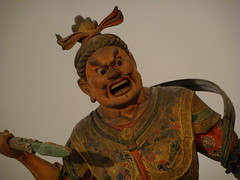I recently spent a week in Japan and while there had the opportunity to visit the national gallery in Ueno park, in Tokyo.
 The visit was wonderful and I had the chance to see amazing 500-year-old pottery from all over Asia, including this Ming bowl. That, of course, was one of the younger pieces as the gallery has many older pieces, including this incredible 400-year-old jar from the Manjiayoo culture of ancient China:
The visit was wonderful and I had the chance to see amazing 500-year-old pottery from all over Asia, including this Ming bowl. That, of course, was one of the younger pieces as the gallery has many older pieces, including this incredible 400-year-old jar from the Manjiayoo culture of ancient China:
After touring the Asian sections of the gallery, I went to the Japanese art section, featuring paintings on huge screens or panels – where I was not allowed to take photos. This was fascinating and enjoyable, but … confusing.
I’m used to Western art. While I’m not an expert by any means whatsoever, I can “read” it to a degree … understand it … appreciate it. Japanese painting, on the other hand is very different … in many ways I cannot read it and do not understand it.
Japanese art, especially traditional Japanese art, seems to almost be more about what is not there than what is. In my limited understanding, this does not appear to be negative space in the western architectural sense, though. Rather, the landscape and objects that are not there are not omissions – they are not removed. Rather, my sense of it is that it’s more of a fading away … a merging with the background which is not background but is also foreground.
Later Japanese art from the 20th and 21st centuries seems more detailed, more western. It employs more tricks of perspective to spatially place objects and scenes in a more “realistic” way. It’s more accessible to my Western eye.
Perhaps next time I go to Japan (if I go) I’ll read up on traditional Japanese art and be able to understand it better.
I did notice, however, that other sections of Japanese art, including sculpture and carving, were far more accessible – though I’m certain that I’m missing many things when viewing these as well.




































